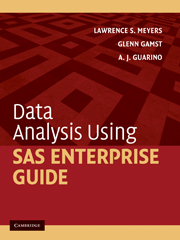Book contents
- Frontmatter
- Contents
- Preface
- Acknowledgments
- I Introducing SAS Enterprise Guide
- II Performing Analyses and Viewing Output
- III Manipulating Data
- IV Describing Data
- V Score Distribution Assumptions
- VI Correlation and Prediction
- VII Comparing Means: The t Test
- VIII Comparing Means: ANOVA
- 23 One-Way Between-Subjects ANOVA
- 24 Two-Way Between-Subjects Design
- 25 One-Way Within-Subjects ANOVA
- 26 Two-Way Mixed ANOVA Design
- IX Nonparametric Procedures
- X Advanced ANOVA Techniques
- XI Analysis of Structure
- References
- Author Index
- Subject Index
23 - One-Way Between-Subjects ANOVA
Published online by Cambridge University Press: 05 June 2012
- Frontmatter
- Contents
- Preface
- Acknowledgments
- I Introducing SAS Enterprise Guide
- II Performing Analyses and Viewing Output
- III Manipulating Data
- IV Describing Data
- V Score Distribution Assumptions
- VI Correlation and Prediction
- VII Comparing Means: The t Test
- VIII Comparing Means: ANOVA
- 23 One-Way Between-Subjects ANOVA
- 24 Two-Way Between-Subjects Design
- 25 One-Way Within-Subjects ANOVA
- 26 Two-Way Mixed ANOVA Design
- IX Nonparametric Procedures
- X Advanced ANOVA Techniques
- XI Analysis of Structure
- References
- Author Index
- Subject Index
Summary
Overview
Analysis of variance (ANOVA) is a family of research and statistical designs allowing us to determine if the means of two or more distributions are significantly different. Each of the next four chapters focuses on a separate ANOVA design.
Naming of ANOVA designs
There are three important pieces of information that are contained in the name of each ANOVA design: the number of independent variables in the design, the number of levels contained in each independent variable, and an indication of the type of independent variables that are included in the design.
The number of independent variables
It is possible to have any number of independent variables in an ANOVA design, although each additional variable that is added substantially escalates the logistics of the data collection. In this chapter and in Chapter 25, we discuss designs containing one independent variable; in Chapters 24 and 26, we discuss designs containing two independent variables.
We communicate the number of independent variables by speaking of n-way designs where n is the count of independent variables. For example, a one-way design contains a single independent variable and a two-way design contains two independent variables.
The number of levels of the independent variables
It is also especially useful when there is more than one independent variable to include an indication of the number of levels of each.
- Type
- Chapter
- Information
- Data Analysis Using SAS Enterprise Guide , pp. 213 - 222Publisher: Cambridge University PressPrint publication year: 2009



